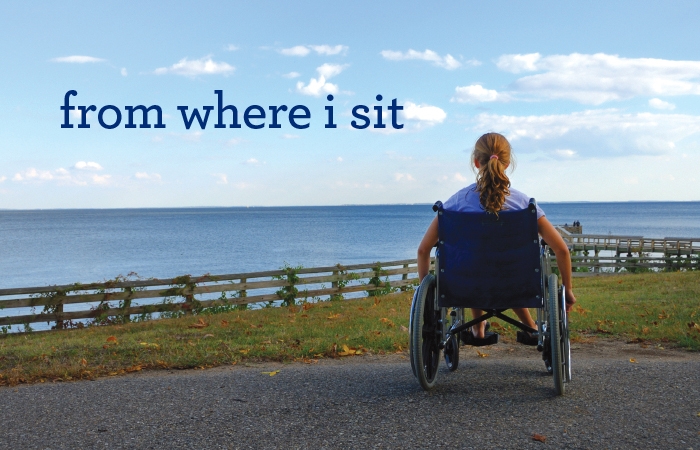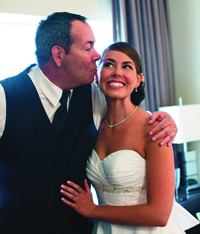
The Best-Worst Thing

After the fear subsided, my diagnosis gave me a healthy perspective on life
Upon hearing my diagnosis — type 1 myotonic muscular dystrophy (MMD, or DM) — at the age of 20, I must admit, my world crumbled for a moment. I’ll never forget how the room seemed to shrink and spin, how the doctor’s voice morphed into white noise, and how visions of immobility caught my breath.
 I looked to the left and saw my father, guilt and unnecessary apologies written on his sullen brow. The same disease had already begun to take hold of his body, and I feared I was looking into a crystal ball.
I looked to the left and saw my father, guilt and unnecessary apologies written on his sullen brow. The same disease had already begun to take hold of his body, and I feared I was looking into a crystal ball.
Can I be honest with you?
I felt like a ticking time bomb; but rather than waiting for a forceful explosion, I was waiting for the slow decline into physical weakness.
The afternoon of my diagnosis, my then-boyfriend (my now-husband) and I took a walk around my neighborhood.
It was a warm October day, and like my outlook on life, the leaves had begun to change. That afternoon I made a choice. I was either going to be a victim of this disease, or a victor of this disease. I chose the latter.
My boogie monster
My MMD diagnosis is what I like to call the best-worst thing that ever could have happened to me.
Not to bible-thump you, but shortly after D-Day, I had a moment of sheer clarity that can only be described as spiritual. A moment where I was able to see the diagnosis for what it was: my turning point.
OK, wait. Let me back up.
Let’s start with my childhood, shall we?
Normal kids grow up fearing the boogie monster; but, friends, I am the farthest thing from normal.
Case in point, during Black History Month in first grade, I wrote a report about Michael Jackson. No, not Martin Luther King Jr., or Rosa Parks. Michael freakin’ Jackson.
If that doesn’t give you my score on the “peculiar scale,” I don’t know what will.
I digress.
I didn’t grow up fearing the boogie monster. I grew up fearing muscular dystrophy. Unfairly, all I knew about the disease was through watching my dad.
I knew MD meant my dad’s muscles didn’t work as well as everyone else’s. I knew it meant that my dad slept more than everyone else. I knew it meant my dad needed my mom to open spaghetti jars.
I knew he wasn’t ever going to get better; I knew I might be just like him, and it terrified me.
I’d take the boogie monster over that stuff any time, any day.
But like any fear, MD wasn’t constantly on my mind. MD wasn’t my life; it was simply a part of it. And besides, it wasn’t my reality — it was my dad’s.
My reality was disordered eating and a severely negative self-body image. I spent years of my life in a losing battle with the mirror, constantly attempting to shrink and fit into a mold in which I didn’t belong. I had let society dictate my definition of beauty, and it was exhausting.
From grade school through college, I hated my body. Part of me feels such shame admitting that. Are you kidding me? I hated my able body.
Yes, you have permission to want to slap me.
I can recall one night in particular: I was in college and routinely berating myself for a dessert I had eaten at the dining hall. Cory (my boyfriend-turned-husband) had heard enough. He told me to leave and not to come back until I had figured myself out.
My turning point
Clearly, Cory couldn’t have been too serious, as I still can’t claim to have myself figured out. But that night I walked home in tears, pleading with God and myself, I want to love myself. Please take this battle away from me.
He answered.
Now we can circle back to my diagnosis being my turning point.
Do I think MD was the answer to my prayers? Hell no! But with the MD diagnosis, I was given a newfound sense of urgency to live life to the fullest.
I could choose to continue on a destructive path, or I could change course. I decided it was time to stop letting life happen to me — and start living instead. He doesn’t know it, but my dad inspired this turning point, as well.
My diagnosis helped me see my dad differently. Instead of seeing him as a person on the decline, I paid closer attention to his stories of jumping out of airplanes, camping in Alaska and dancing at concerts. He’s lived life, and he’s lived it well.
An MD diagnosis is scary, sure, but it’s inspired me to do everything I want.
Soon after my diagnosis, I ran my first half-marathon. Prior to my diagnosis, I’d only run if a murderer was chasing me, but this was an exercise in taking control of my body, taking care of my body and pushing it to healthy physical limits I never thought possible.
Following my diagnosis, I did something else that scared me: I started my blog. I’ve written since I was young but was always too scared to share it with anyone.
Now, I use my blog as a platform to encourage thousands of other women to embrace themselves, to accept themselves and to love the fact that they are perfectly imperfect.
So, yeah, MD has been the best-worst thing that has happened to me. It’s been scary and difficult and trying. But without a doubt, it has turned me into the bravest version of myself I could ever possibly imagine.
Colleen Whitney Nichols, 26, is a lifestyle blogger in Richmond, Va., living with type 1 myotonic muscular dystrophy.
If you or a loved one is facing a new diagnosis, your local MDA office and clinic can help you plan for everything from career and home resources to insurance and durable medical equipment needs. Find the clinic in your area, and get started working with your MDA clinic team today.
If you have a “From Where I Sit” story idea, let us know by emailing the Quest editors at publications@mdausa.org.
MDA Resource Center: We’re Here For You
Our trained specialists are here to provide one-on-one support for every part of your journey. Send a message below or call us at 1-833-ASK-MDA1 (1-833-275-6321). If you live outside the U.S., we may be able to connect you to muscular dystrophy groups in your area, but MDA programs are only available in the U.S.
Request Information